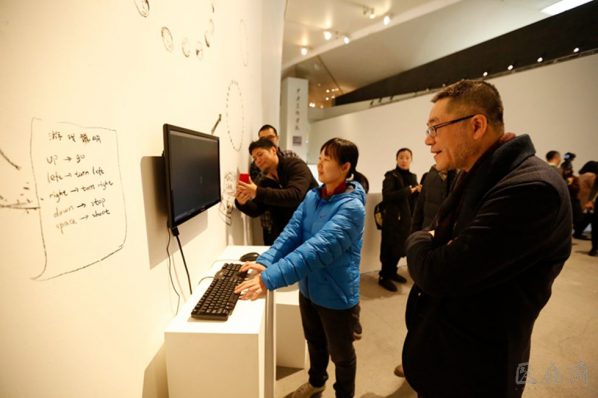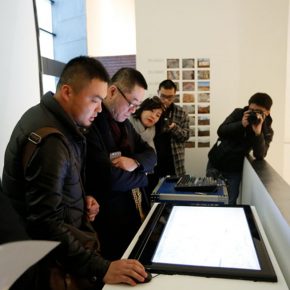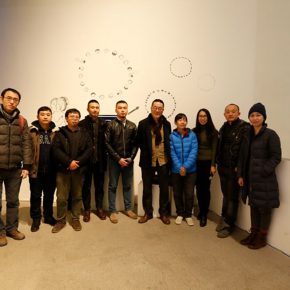
In terms of the development of media technology, the first year of new media technology shall be 1946 as the first computer “ENIAC” was manufactured by the University of Pennsylvania in that year. Strictly speaking, its birth made the appearance of new media art possible. But, just as Lev Manovich, a theorist of new media art, proposes: new media is a combination of the existing cultural conventions and the conventions of software; new media is the aesthetics that accompanies the early stage of every new modern media and communication technology; new media is the encoding of modernist avant-garde, new media is meta-media. Therefore, new media, as an aesthetic value, has actually been prior to the birth of new media technology and included in the convention of social culture and the art concept of modernist avant-garde.
This exhibition tries to present the following questions on a theoretical basis:
Firstly, new media art is included in the whole framework of art history. The immersion effect of new media art and visual illusion caused by scenography are simultaneously discussed. Making VR as an extension of the sensory effect of visual illusion caused by scenography on a two-dimensional surface since the Renaissance.
Secondly, new media is taken as a way of thinking. Seen from the perspective of development of the artistic medium, new media is similar to the medium of artistic creation in the past. They are just a creation tool, so pursuing the “new” of media technology cannot be taken as the ultimate target of new media art. However, new media is essentially different from traditional art media. New media has become an indispensable part of contemporary society and thoroughly affects our daily life. Such social conditions are far superior to any art media in the past. Essentially, it is a new way of thinking that is affected by such social conditions which is reflected in the works of the artists, it is not only about new media art but also affects artistic forms of all media. Behind these works, we shall explore the process to remold the thinking in the new media epoch, and the potential and new art aesthetics, including digital, precision, coexistence and sharing. In other words, this shall be a primary cause that new media art is regarded as the “new”.
The last one and also the essential concept is new media technology has played the main role in comprehensive transformation of human society. It is predicted that the demarcation line between virtual and reality will be ever-increasingly obfuscated and united as one in the near future. This has predicted the largest feature of new media society at this mature stage – virtual is reality. I believe that this is not only the context of new media thinking but also an aesthetic criterion for new media art.
Text and photo courtesy of the CAFA Art Museum
About the Exhibition
Duration: January 14 – February 19, 2017
Venue: Exhibition Hall 2C, CAFA Art Museum
Curator: Shi Guanzhe
Participating Artists: Deng Dafei, Fu Shuai, Ma Liang, Xia Tian, Zhang Jing
About the Curator
Shi Guanzhe
Curator, graduated from the Department of Art Management at the School of Humanities, CAFA. He has been engaged in the planning of contemporary art exhibitions and art criticism, focusing on the study of new media art.
About the Artists
Deng Dafei
In 2005, he graduated from the Department of Integrated Art at the China Academy of Art. Currently he lives in Beijing, an independent artist. The expression of early works focused on the creation of behavioral video recordings based on the body. Along with the slight change of life in Beijing, his thinking gradually turns from focusing on the inner spiritual experience to focusing on the categories of visual cultural research such as external environment, humanistic geography and so on.
Fu Shuai
Born in Taiyuan, Shanxi in 1985, Fu Shuai graduated from the Department of Comprehensive Painting at the Tianjin Academy of Fine Arts, with a bachelor’s degree in 2008. In 2010, he went to Karlsruhe Academy of Fine Arts in Germany as an exchange student. In 2011, he graduated from the Department of Comprehensive Art at Tianjin Academy of Fine Arts, with a master’s degree. He was the co-founder of Recycling Space Program which was established in 2012. Now he works and lives in Tianjin.
Ma Liang
Born in Xi’an in 1983, Ma Liang is a young teacher of MMAD at the School of Experimental Art, Tianjin Academy of Fine Arts. In 2014 Ma graduated from the Digital Media Studio at CAFA, majored in the research of media art, with a master’s degree.
Xia Tian
Born in 1982, Xia Tian graduated from college and now he is working in a state-owned enterprise. For a long time, he has spent his free time engaged in the creation of contemporary art for a long time. In recent years, the artist starts from an historical, political and social perspective to unfold the work around spatial production.
Zhang Jing
Zhang Jing graduated from the Department of Oil Painting at Guangzhou Academy of Fine Arts in 2015, received a master’s degree.




















































